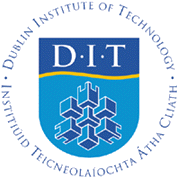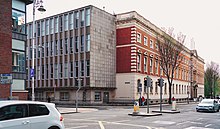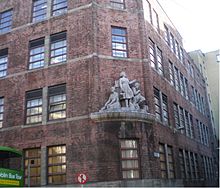Dublin Institute of Technology
Institiúid Teicneolaíochta Bhaile Átha Cliath | |
 | |
| Active | 1887 – foundation of City of Dublin Technical Schools 1978 – under the auspices of Dublin City Council 1992 – as an autonomous degree-awarding institution.–2019 – became part of Technological University Dublin |
|---|---|
| President | Professor Brian Norton |
Academic staff | 2,500[1] |
| Students | 20,000 |
| Address | Grangegorman , Dublin 7 Dublin , Ireland |
| Campus | Multiple locations in Dublin. Relocating to a single inner suburban campus. |
| Colours | Blue, Beige, |
| Affiliations | EUA
IAU
ELIA
SEFI |
| Website | dit.ie |

Dublin Institute of Technology (commonly referred to as DIT) (Irish: Institiúid Teicneolaíochta Bhaile Átha Cliath) was a major third-level institution in Dublin, Ireland. On 1 January 2019 DIT was dissolved and its functions were transferred to the Technological University Dublin. The institution began with the establishment of the first technical education institution in Ireland, in 1887, and progressed through various legal and governance models, culminating in autonomy under a statute of 1992.
DIT was recognised particularly for degree programmes in Product Design, Mechanical Engineering, Architecture, Engineering, Science, Marketing, Hospitality, Music, Optometry, Pharmaceuticals, Construction, Digital Media and Journalism.[citation needed] It was ranked, in 2014, in Times Higher Education's top 100 university-level institutions globally under 50 years old.[2]
Influential contributions to policy debates have often placed DIT at the heart of many diverse aspects of public life in Dublin.[citation needed] Alumni of the Dublin Institute of Technology include many of Ireland's leading writers, artists, politicians and business leaders as well as many international figures successful in arts, architecture and business.[3] DIT's students have come from all parts of the world. Spin-out businesses from DIT employ over 1400 people.[citation needed]
History[]
Origins – Dublin's technical colleges[]

The first of DIT's predecessor colleges, the City of Dublin Technical Schools, was founded in 1887 by Arnold Felix Graves.
Over time, other specialised colleges opened, and those which later formed DIT are listed, each with its year of foundation:
- College of Technology, Kevin Street (1887)
- College of Music, Chatham Row (1890)
- College of Commerce, Rathmines (1901)
- College of Marketing and Design, Mountjoy Square (1905)
- College of Technology, Bolton Street (1911)
- College of Catering, Cathal Brugha Street (1941)
Federal model (1978–1992)[]
In 1978 the College of Technology joined with the other five institutions to form the Dublin Institute of Technology, a federation of colleges.[4]
Unitary college model[]
In 1992, Dublin Institute of Technology was established by legislation as a single institution, under the Dublin Institute of Technology Act.[5]
Towards university status[]
An application for university designation in 1996 was declined but with the expert panel viewing the institution as on a trajectory for university designation. Dublin Institute of Technology now has a scope of activities and variety of powers identical to those of a university, and its degrees are recognised as such both in Ireland and internationally. For twenty-five years, DIT has had legislative authority to award Bachelor's, Master's and Doctoral degrees that comply fully with the Irish national qualifications framework originally put in place by the National Qualifications Authority of Ireland. DIT has awarded Professorships since 2003.
Technological University status[]
In 2014, the institution entered into a formal process[6][7] which led to its designation as a technological university, jointly with two other institutions, Institute of Technology, Blanchardstown and Institute of Technology, Tallaght.[8][9] A final application was submitted in April 2018 and the formation of the Technological University Dublin, "TU Dublin", was approved in July 2018.[10][11] It was launched 1 January 2019.[12][13]
Degree-awarding powers[]
In 1975 the University of Dublin entered into an agreement whereby it conferred academic degrees at the colleges that formed Dublin Institute of Technology; this allowed these graduates a vote in the University of Dublin constituency for Seanad Éireann representatives. This continued until 1998, when Dublin Institute of Technology was granted its own autonomous degree-awarding powers under the Dublin Institute of Technology Act 1992.[5]
Academic structure[]
DIT's predecessor colleges were recognised as centres of excellence in their areas of specialism and, following the establishment of the unitary DIT, their expertise formed the nucleus of an internal structure comprising the following faculties and campuses:
- Faculty of Applied Arts, Mountjoy Square, Rathmines, Clarendon Row, Portland Row, Temple Bar
- Faculty of the Built Environment, Bolton Street and Linenhall
- Faculty of Business, Mountjoy Square and Rathmines, latterly Aungier Street
- Faculty of Engineering, Bolton Street, Kevin Street, Beresford Street
- Faculty of Science, Kevin Street
- Faculty of Tourism and Food, Cathal Brugha Street, Sackville Place and Kevin Street
From 2012 to 2018, DIT was organised into four Colleges: Engineering and Built Environment, Business, Science and Health, and Arts and Tourism. These also contributed to the research activities of an overarching Graduate Research School and to four cross-institutional Research Institutes that brought together over seventy research centres and groups. The Colleges in turn were divided into 27 Schools.
DIT also had various technology transfer and commercial units.
Governance[]
DIT had a Governing Body comprising representatives of public, including Dublin Lord Mayors (such as formerly Maurice Ahern and Mary Freehill), social and industrial groups, faculty, staff and students, its final composition was chaired by Professor Tom Collins.

In 1992 Michael O'Donnell became the first interim President. He was succeeded as president in 1993 by Professor Brendan Goldsmith.[14] From 2003 to 2018 Professor Brian Norton was the second, and last, President.[15]
Faculty[]
Current faculty include David Brophy, conductor, Gráinne Mulvey, composer, Bernie Sherlock, conductor, Jane O'Leary, pianist and composer, John Feeley, guitarist, Kieran Hanrahan, traditional Irish musician, Mike Nielsen, jazz guitarist and composer, Ciarán Cuffe, urban planner, Mairtin Mac Con Iomaire, culinary arts.
Previous faculty members include Pat Kenny, Raidió Teilifís Éireann (RTÉ and Newstalk) news and current affairs presenter, Joan Burton, Teachta Dála (TD), Minister for Social Protection, Frank Harte, Irish traditional singer and architect, Hugh McFadden, poet, Seán Dublin Bay Rockall Loftus, politician, Brid Grant, Dean of Arts, University of Connecticut, Desmond Fennell, writer and cultural philosopher, Lelia Doolan, TV and film producer, Peter Sutherland, lawyer and politician. John T. Lewis, mathematician and physicist and Bernadette Greevy, mezzo-soprano.[citation needed]
Research[]
Dedicated research facilities include the Focas Research Institute with extensive spectroscopy, microscopy and holography facilities. It also houses "CREST"; an international centre supported by Enterprise Ireland for paint and surface coating development. Antennae research is associated with the multi-institution "CTVR"; The Centre for Telecommunications Value-added Research.[16] Recently research supported by Science Foundation Ireland in the Dublin Energy Lab, water sciences, air quality, food preservation and environmental health and safety are being co-located in a major new building at the Grangegorman new city centre campus together with an additional "Hothouse" start-up business incubator for new DIT spin-off companies. Hothouse has nurtured, amongst other firms, Smart Wall Paint and Moletest.[citation needed]
National Optometry Centre[]
The National Optometry Centre (NOC) located at the junction of Kevin Street and New Bride Street is a state-of-the-art facility[citation needed] and the only such centre in Ireland. The main function of the NOC is to facilitate clinical training for Optometry students. The Centre is developing specialised clinics in areas such as paediatrics, low vision and contact lenses. It will also offer eye examinations, spectacles and contact lenses to the general public. Free eye examinations are offered to DIT students.[citation needed]
Partnerships[]
In common with other Irish universities, DIT validates programmes taught in other institutions in Dublin such as Pulse College, based in the Windmill Lane Studios, and the British and Irish Modern Music Institute BA programme. Also, these external courses are also reviewed on an ongoing basis to ensure that they still maintain the high level expected from DIT/DUT course standards.[citation needed]
There are extensive student exchange and joint research programmes with leading universities in India, China, Brazil, Australia, the US and across Europe. DIT are lead partners in the Mozambique Eyecare Project. As part of the project, an undergraduate course in Optometry has been established at Universidade Lurio, Nampula. The first of its kind in Mozambique. Other partners on the project are University of Ulster and International Centre for Eyecare Education. There are strong links with Darmstadt University of Applied Sciences across many subjects, with Columbia College Chicago in design and media and with Purdue University across many disciplines including a joint master's degree programme. There are strong student and staff exchanges with Grenoble School of Management. DIT accredits programmes at Middle East College in Oman.[citation needed]
Ranking[]
Dublin Institute of Technology was named "Best Institute of Technology" in 2010, 2016 and 2018 by the Sunday Times. It came 94th in the 2014[2] and 2015 Times Higher Education 100 under 50 Ranking of universities worldwide. It came 157th in the UI Greenmetric Ranking of World Universities in 2013.[17] The 2012, QS World University Rankings puts DIT in the 451–500 bracket worldwide and in the 350th position for Engineering & Technology; DIT's best result in the same ranking was when it came 326th in the worldwide ranking in 2009.[18]

Community outreach[]
Embedded in the life of Dublin city centre, DIT has built very strong and diverse links with its neighbouring communities and schools. The Access and Civic Engagement service provides extensive programmes that enable those from traditionally under-represented groups to study at DIT. These include many highly successful access routes for children in secondary schools where there has been no tradition of continuing to third level education. It has also made even earlier interventions in schools, for example the 'Pathways through Education' supports students in making the transition into secondary school.
Campus[]
Dublin Institute of Technology is spread across 10 locations in Dublin city, which are currently being amalgamated into a central campus at Grangegorman.
Grangegorman Campus[]

The Institute plans to consolidate to a single campus in the centre of Dublin, at Grangegorman.[19] The campus is located 1 km from O’Connell Street, with Smithfield to the south; Stoneybatter to the west; Broadstone to the east; and Phibsboro and the North Circular Road to the north. The Grangegorman campus is currently home to students in Fine Art, Product Design, Visual Communications, Photography and Social Sciences.[20] The development of the new consolidated city-centre campus is undertaken by the Grangegorman Development Agency.
The campus is served by the Luas (Green Line) and the closest station is Grangegorman. An adjacent station, DIT Broadstone, is operational although at present there is no direct access to the campus. This will be opened up once the development of the campus is complete.



Students[]
Dublin Institute of Technology had circa 20,000 students.[citation needed]
Students' Union[]
The DIT Students' Union is the representative body for all students in the Dublin Institute of Technology and it ensures there is a student voice at each level within the College. All students within the Institute are automatically members. In addition it promotes Clubs, Societies and other non-academic activities and provides a range of services for its members.
Sport[]
DIT has more than 40 student clubs,[21] including Gaelic Athletic Association, football, Handball, rifle shooting, waterpolo, archery, basketball, kite surfing, cricket and many more.
In 2013 Dublin Institute of Technology won the Sigerson Cup, the premier Gaelic Football Championship among Irish Higher Education institutions. DIT's hurlers won the Kehoe Cup in 2007 and the Walsh Cup Shield in 2013.
Outdoor and indoor sports facilities are being developed at Grangegorman and at Broom Bridge. The latter is adjacent to Broombridge railway station and the canal bridge where Sir William Rowan Hamilton first wrote the fundamental formula for quaternions.
Notable alumni[]
See also[]
- Education in the Republic of Ireland
- List of higher education institutions in the Republic of Ireland
- Grangegorman Development Agency
References[]
- ^ "Electrical and Electronic Engineering DIT" (PDF). DIT SEEE. Archived from the original (PDF) on 26 January 2016. Retrieved 9 January 2016.
- ^ Jump up to: a b "DIT makes 'top100' for up-and-coming third-level institution". Irish Times. 30 April 2014.
- ^ Robinson, Jimmie (2007). From Certificates to Doctorates,by Degrees; Dublin Institute of Technology – a Photographic Memoir. ISBN 978-1-84218-143-0.
- ^ Duff, Tom; et al. (2000). The Story of Dublin Institute of Technology. Blackhall Press. ISBN 1-842180-13-4.
- ^ Jump up to: a b "Dublin Institute of Technology Act 1992". www.irishstatutebook.ie. Retrieved 3 April 2020.
- ^ "ITs or Tech Unis". Irish Times. 16 February 2014.
- ^ "The transforming landscape of higher education in Ireland". Public Affairs Ireland. 4 April 2014.
- ^ DIT seeks an upgrading to university, Independent.ie, 20 October 2006, archived from the original on 18 June 2011, retrieved 13 September 2010
- ^ Peter McGuire (15 March 2016). "Technological universities: are they really such a good idea?". The Irish Times.
- ^ "Announcement by An Taoiseach Leo Varadkar". Dublin Institute of Technology. 17 July 2018. Retrieved 17 July 2018 – via facebook.com.
- ^ "Application for designation as Ireland's first Technological University has been successful!". Dublin Institute of Technology. 17 July 2018. Retrieved 17 July 2018 – via facebook.com.
- ^ "TU Dublin now Ireland's largest institution as ITs merge". RTÉ.ie. 1 January 2019. Archived from the original on 1 January 2019.
- ^ O'Keefe, Emma (17 July 2018). "Approval to be given for Ireland's first technological university". RTÉ. Archived from the original on 17 July 2018. Retrieved 17 July 2018.
- ^ "Taking the lead: Dr Brendan Goldsmith". The Irish Times. Retrieved 3 April 2020.
- ^ "Prof Brian Norton reappointed as DIT President". The Irish Times. Retrieved 3 April 2020.
- ^ "CTVR website".
- ^ "Greenmetric rankings 2013". Archived from the original on 1 February 2014.
- ^ "2012 QS World University Rankings: Dublin Institute of Technology". QS Top Universities. 2012. Archived from the original on 3 May 2013. Retrieved 18 November 2012.
- ^ "Finishing touches as DIT campus opens in the heart of city". Irish Times. 4 September 2014.
- ^ "DIT opens new campus in Grangegorman to first students". Irish Independent. 10 September 2014.
- ^ "DIT Clubs". Archived from the original on 13 March 2014. Retrieved 13 March 2014. Also here
External links[]
![]() Media related to Dublin Institute of Technology at Wikimedia Commons
Media related to Dublin Institute of Technology at Wikimedia Commons
- Dublin Institute of Technology
- Technological University Dublin
- Education in Dublin (city)
- 1887 establishments in Ireland
- Further education colleges in Dublin (city)
- Educational institutions established in 1978
- Educational institutions disestablished in 2019
- Science and technology in Ireland
- Business schools in the Republic of Ireland
- Art schools in Ireland
- Former universities and colleges in the Republic of Ireland
- 2019 disestablishments in Ireland
